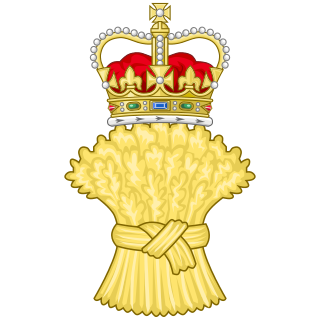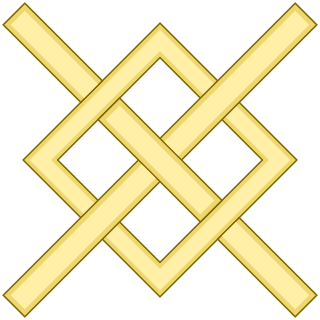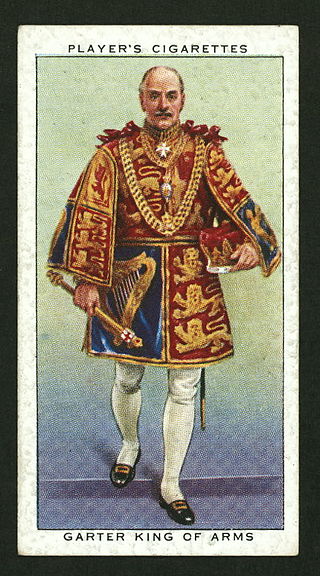
Duke of Norfolk is a title in the peerage of England, and is the premier non-royal peerage. The seat of the Duke of Norfolk is Arundel Castle in Sussex, although the title refers to the county of Norfolk. The current duke is Edward Fitzalan-Howard, 18th Duke of Norfolk. The dukes have historically been Catholic, a state of affairs known as recusancy in England.

The College of Arms, or Heralds' College, is a royal corporation consisting of professional officers of arms, with jurisdiction over England, Wales, Northern Ireland and some Commonwealth realms. The heralds are appointed by the British Sovereign and are delegated authority to act on behalf of the Crown in all matters of heraldry, the granting of new coats of arms, genealogical research and the recording of pedigrees. The College is also the official body responsible for matters relating to the flying of flags on land, and it maintains the official registers of flags and other national symbols. Though a part of the Royal Household of the United Kingdom, the College is self-financed, unsupported by any public funds.

Edward William Fitzalan-Howard, 18th Duke of Norfolk,, styled Earl of Arundel between 1975 and 2002. He is a British peer who holds the hereditary office of Earl Marshal. As Duke of Norfolk, he is the most senior peer in the peerage of England. He is also the titular head of the House of Howard.

Norroy and Ulster King of Arms is the provincial King of Arms at the College of Arms with jurisdiction over England north of the Trent and Northern Ireland. The two offices of Norroy and Ulster were formerly separate. Norroy King of Arms is the older office, there being a reference as early as 1276 to a "King of Heralds beyond the Trent in the North". The name Norroy is derived from the Old French nort roy meaning 'north king'. The office of Ulster Principal King of Arms for All-Ireland was established in 1552 by King Edward VI to replace the older post of Ireland King of Arms, which had lapsed in 1487.

Richmond Herald of Arms in Ordinary is an officer of arms of the College of Arms in England. From 1421 to 1485, Richmond was a herald to John, Duke of Bedford, George, Duke of Clarence, and Henry, Earl of Richmond, all of whom held the Honour (estate) of Richmond. However, on the accession of Henry as Henry VII of England in 1485, Richmond became a king of arms and remained so until 1510, when the office became that of a herald in ordinary of the Crown. The badge of office is a red rose of Lancaster dimidiating the white rose en soleil of York, ensigned by the royal crown. Although this device has all the characteristics of a Tudor invention, it is likely to be of fairly recent derivation.

Chester Herald of Arms in Ordinary is an officer of arms at the College of Arms in London. The office of Chester Herald dates from the 14th century, and it is reputed that the holder was herald to Edward, Prince of Wales, also known as the Black Prince. In the reign of King Richard II the officer was attached to the Principality of Chester, which was a perquisite of the then Prince of Wales. In the reign of King Henry VIII the title lapsed for a time but, since 1525, the office of Chester has been one of unbroken succession, as a herald in ordinary. The badge of office is taken from the arms of the Earl of Chester and in blazoned as A Garb ensigned of the Royal Crown Or.

York Herald of Arms in Ordinary is an officer of arms at the College of Arms. The first York Herald is believed to have been an officer to Edmund of Langley, Duke of York around the year 1385, but the first completely reliable reference to such a herald is in February 1484, when John Water alias Yorke, herald was granted certain fees by Richard III. These fees included the Manor of Bayhall in Pembury, Kent, and 8 pounds, 6 shillings, and 8 pence a year from the Lordship of Huntingfield in Kent. The badge of office is the White Rose of York en soleil ensigned by the Royal Crown.

Somerset Herald of Arms in Ordinary is an officer of arms at the College of Arms in London. In the year 1448 Somerset Herald is known to have served the Duke of Somerset, but by the time of the coronation of King Henry VII in 1485 his successor appears to have been raised to the rank of a royal officer, when he was the only herald to receive coronation liveries.

Windsor Herald of Arms in Ordinary is an officer of arms at the College of Arms in London.

Beaumont Herald of Arms Extraordinary was an officer of arms extraordinary in England. Beaumont was a royal herald, but was not a member of the College of Arms. The office was created in 1982 and named after the barony of Beaumont, one of the subsidiary titles of the Earl Marshal, the Duke of Norfolk. The badge of office combines the cross potent of the Kings of Jerusalem from whom the Beaumonts are descended, with the lion and fleur-de-lis charges from the family coat of arms. It is blazoned In front of a Cross Potent a Lion rampant within eight Fleurs-de-lis in orle Or.

Maltravers Herald of Arms Extraordinary is a current officer of arms extraordinary in England. As such, Maltravers is a royal herald, but is not a member of the College of Arms in London. The present office was created in 1887 by the Earl Marshal, who was also the Duke of Norfolk and Baron Maltravers. The office is known to have been held by a pursuivant to Lord Maltravers when he was deputy of Calais from 1540 to 1544. The badge is blazoned as A Fret Or. It was officially assigned in 1973, though it had been assumed by two Maltravers Heralds in the 1930s. It derives from the coat of arms of Maltravers Sable a Fret Or and a Label of the points Ermine, and was the badge of John, Earl of Arundel through which family the barony passed to the Howard dukes of Norfolk.

Wales Herald of Arms Extraordinary is a current Officer of Arms Extraordinary under the Courts of England and Wales' jurisdiction. Wales is a Royal Herald, ie a member of the Royal Household, and while not being a member of chapter of the College of Arms, processes with the other heralds at ceremonial occasions. Wales Herald forms an integral part of the procession when the British monarch officially opens a session of Senedd Cymru/Welsh Parliament at Cardiff Bay.

Norfolk Herald of Arms Extraordinary is an officer of arms in England. As an officer extraordinary, Norfolk is a royal herald, though not a member of the corporation of the College of Arms in London. Beginning in 1539 this officer was a herald to the dukes of Norfolk, though the first holder, John James, was paid a salary by King Henry VIII. Subsequent Norfolk heralds have been officers extraordinary, though the office has not always been filled but rather revived when required. The badge of office, assigned in 1958, is blazoned as Two Ostrich Feathers saltirewise each charged with a Gold Chain laid along the quill. It derives from the ostrich feather badge granted by King Richard II around 1387 as a mark of special favor to Thomas Mowbray, Duke of Norfolk, Marshal of England. Mowbray was also the first to be styled Earl Marshal.

Fitzalan Pursuivant of Arms Extraordinary is a current officer of arms in England. As a pursuivant extraordinary, Fitzalan is a royal officer of arms, but is not a member of the corporation of the College of Arms in London. As with many other extraordinary offices of arms, Fitzalan Pursuivant obtains its title from one of the baronies held by the Duke of Norfolk, Earl Marshal of England; the appointment was first made for the coronation of Queen Victoria in 1837. The badge of office was assigned in 1958 and is derived from a Fitzalan badge of the fifteenth century. It can be blazoned An Oak Sprig Vert Acorns Or, but is also recorded as A Sprig of Oak proper.
Sir Walter John George Verco was a long-serving officer of arms who served in many capacities at the College of Arms in London.
Charles WilfridScott-Giles was an English writer on heraldry and an officer of arms, who served as Fitzalan Pursuivant Extraordinary.

Surrey Herald of Arms Extraordinary was an English officer of arms. Though an officer of the crown, Surrey Herald Extraordinary was not a member of the corporation of the College of Arms in London. This office was created in 1856 and first held by Edward Stephen Dendy. The badge of office was assigned in 1981. The badge is blazoned Within a representation of a Herald's Collar of SS Argent a Tabard chequy Or and Azure. These were the arms of John de Warenne, Earl of Surrey in the late thirteenth century, from whom the earldom descended through the Fitzalans to the Howard dukes of Norfolk and earls marshal.

Sir Gerald Woods Wollaston was a long-serving officer of arms at the College of Arms in London. Wollaston's family had a firm tradition at the College of Arms. Wollaston's great-grandfather was Sir William Woods, Garter Principal King of Arms from 1838 until his death in 1842. His grandfather was Sir Albert William Woods who held the same post from 1869 to 1904.
Blanche Lyon Pursuivant of Arms in Ordinary was an English office of arms created during the reign of King Edward IV.

Howard Pursuivant of Arms Extraordinary was an officer of arms extraordinary in England; that is, a royal herald but not a member of the College of Arms in London.



























